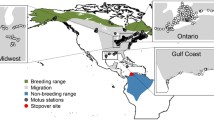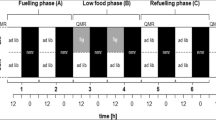Abstract
Birds migrating between widely separated wintering and breeding grounds may choose among a number of potential stopover sites by using different itineraries. Our aim is to predict the optimal migration schedule in terms of (1) rates of fuel deposition, (2) departure fuel loads and (3) stopover site use, when only a handful of such sites are available. We assume that reproductive success depends on the date and fuel load at arrival on the breeding grounds. On migration, the birds face a trade-off between gaining fuel and avoiding predation. To allow the optimal decision at any given moment to depend on the fuel load and the location of the bird, as well as on unpredictability in conditions, we employed stochastic dynamic programming. This technique assumes that the birds know the probability distribution of conditions in all sites, but not the particular realization they will encounter. We examined the consequences of varying aspects of the model, like (1) the shape of the relationship between arrival date and fitness, (2) the presence of stochasticity in fuel deposition rates and wind conditions, and (3) the nature of predation (i.e. whether predation risk depends on the fuel load of the birds or their feeding intensity).
Optimal fuel deposition rates are predicted to be constant if there are either only predation risks of maintaining stores or only risks of acquiring fuel stores. If only fuel acquisition is risky, fuel deposition rates can be below maximum, especially if there also is an intermediate best arrival time at the breeding ground. The fuel deposition rate at a site then depends not just on the site's quality but on the qualities of all visited sites. In contrast, rates of fuel deposition are not constant if both the acquisition and the maintenance of fuel stores carry risk. Optimal departure fuel loads are just enough to reach the next site if the environment is deterministic and are simply set by the energetic cost of covering the distance. As with time-minimizing models, more fuel than necessary to reach a site is only deposited under very restricted circumstances. Such overloads are more likely to be deposited if either fuel gains or expenditure are stochastic. The size of overloads is then determined by the variance in fuel gain at the target site and the worst possible conditions during flight. Site use is modified by differences in predation risk between sites and differences in fuel deposition rates. An expression derived to predict site use under time minimization provides a good approximation in state-dependent models. In some cases, the possibility of starvation may influence optimal decisions, even when the probability of starvation under the optimal policy is low. This effect of starvation has also been found in other contexts.
Similar content being viewed by others
References
Alerstam, T. and Lindström, Å. (1990) Optimal bird migration: The relative importance of time, energy, and safety. In Bird Migration: The Physiology and Ecophysiology (E. Gwinner, ed.), pp. 331–351. Springer, Berlin.
Bijlsma, G.R. (1990) Predation by large falcon species on wintering waders on the Banc d'Arguin, Mauritania. Ardea 78, 75–82.
Creswell, W. (1993) Escape responses by redshanks, Tringa totanus, on attack by avian predators. Anim. Behav. 46, 609–611.
Creswell, W. (1994) Flocking is an effective anti-predation strategy in redshank, Tringa totanus. Anim. Behav. 47, 433–442.
Daan, S., Dijkstra, C. and Tinbergen, J.M. (1990) Family planning in the kestrel (Falco tinnunculus): The ultimate control of covariation of laying date and clutch size. Behaviour 114, 83–116.
Davidson, N.C. and Evans, P.R. (1988) Prebreeding accumulation of fat and muscle protein by Arctic-breeding shorebirds. Acta XIX Congr. Internat. Ornithol. (Ottawa), 342–352.
Drent, R.H. and Daan, S. (1980) The prudent parent: Energetic adjustments in avian breeding. Ardea 68, 225–252.
Ens, B.J., Piersma, T. and Tinbergen, J.M. (1994) Towards predictive models of bird migration schedules: Theoretical and empirical bottlenecks. NIOZ-report 1994–95.
Evans, P.R. (1991) Seasonal and annual patterns of mortality in migratory shorebirds: Some conservation implications. In Bird Population Studies (C.M. Perrins, J.-D. Lebreton and G.J.M. Hirons, eds), pp. 346–359. Oxford University Press, Oxford.
Fransson, T. and Weber, T.P. (1997) Migratory fuelling of blackcaps Sylvia atricapilla under the perceived risk of predation. Behav. Ecol. Sociobiol. 41, 75–80.
Goss-Custard, J.D. (1984) Intake rates and food supply in migrating and wintering shorebirds. Behav. Mar. Anim. 6, 233–270.
Green, G.H., Greenwood, J.J.D. and Lloyd, C.S. (1977) The influence of snow condition on the date of breeding of wading birds in north-east Greenland. J. Zool. (Lond) 183, 311–328.
Gudmundsson, G.A., Lindström, Å. and Alerstam, T. (1991) Optimal fat loads and long distance flights by migrating Knots, Sanderlings and Turnstones. Ibis 133, 140–152.
Hedenström, A. (1992) Flight performance in relation to fuel loads in birds. J. Theor. Biol. 158, 535–537.
Houston, A.I. and McNamara, J.M. (1993) A theoretical investigation of the fat reserves and mortality levels of small birds in winter. Ornis Scand. 24, 205–219
Houston, A.I., McNamara, J.M. and Hutchinson, J.M.C. (1993) General results concerning the trade-off between gaining energy and avoiding predation. Phil. Trans. R. Soc. Lond. B 341, 375–397.
Kersten, M. and Visser, W. (1996) The rate of food processing in the Oystercatcher: Food intake and energy expenditure are constrained by a digestive bottleneck. Funct. Ecol. 10, 440–448.
Liechti, F., Hedenström, A. and Alerstam, T. (1994) Effect of sidewinds on optimal flying speeds of birds J. Theor. Biol. 170, 219–225.
Lindström, Å. and Piersma, T. (1993) Mass changes in migrating birds: The evidence for fat and protein storage re-examined. Ibis 135, 70–78.
Lindström, Å., Hasselquist, D., Bensch, S. and Grahn, M. (1990) Asymmetric contests over resources for survival and migration: A field experiment with bluethroats. Anim. Behav. 40, 453–461.
Mangel, M. and Clark, C.W. (1986) Towards a unified foraging theory. Ecology 67, 1127–1138.
Mangel, M. and Clark, C.W. (1988) Dynamic Modeling in Behavioral Ecology. Princeton University Press, Princeton, NJ.
McNamara, J.M. and Houston, A.I. (1986) The common currency for behavioural decisions. Am. Nat. 127, 358–378.
McNamara, J.M., Mace, R.H. and Houston, A.I. (1987) Optimal daily routines of singing and foraging. Behav. Ecol. Sociobiol. 20, 399–405.
McNamara, J.M., Houston, A.I. and Lima, S.L. (1994) Foraging routines of small birds in winter: A theoretical investigation. J. Avian Biol. 25, 287–302.
Metcalfe, N.B. and Furness, R.W. (1984) Changing priorities: The effect of premigratory fattening on the trade-off between foraging and vigilance. Behav. Ecol. Sociobiol. 15, 203–206.
Møller, A.P. (1994) Phenotype-dependent arrival time and its consequences in a migratory bird. Behav. Ecol. Sociobiol. 35, 115–122.
Moore, F.R. and Simm, P.A. (1986) Risk-sensitive foraging by a migratory bird (Dendroica coronata). Experientia 42, 1054–1056.
Mouritsen, K.N. (1992) Predator avoidance by night-feeding dunlins (Calidris alpina): A matter of concealment. Ornis Scand. 23, 195–198.
Page, G. and Whitacre, D.F. (1975) Raptor predation on wintering shorebirds. Condor 77, 73–83.
Pennycuick, C.J. (1975) Mechanics of flight. In Avian Biology, Vol. V (D.S. Farner and J.R. King, eds), pp. 1–75. Academic Press, London.
Piersma, T. (1987) Hop, skip or jump? Constraints on migration of Arctic waders by feeding, fattening and flight speed. Limosa 60, 185–194 (in Dutch with English summary).
Piersma, T. (1994) Close to the edge: Energetic bottlenecks and the evolution of migratory pathways in Knots. PhD thesis, University of Groningen, The Netherlands.
Piersma, T. and van de Sant, S. (1992) Pattern and predictability of potential wind assistance for waders and geese migrating from West Africa and the Wadden Sea to Siberia. Ornis Svevica 2, 55–66.
Piersma, P., Verkuil, Y. and Tulp, I. (1994) Resources for long-distance migration of knots Calidris canutus islandica and C. c. canutus: How broad is the temporal exploitation window of benthic prey in the western and eastern Wadden Sea? Oikos 71, 393–407.
Rayner, J.M.V. (1990) The mechanics of flight and bird migration performance. In Bird Migration: The Physiology and Ecophysiology (E. Gwinner, ed.), pp. 283–299. Springer, Berlin.
Rowe, L., Ludwig, D. and Schluter, D. (1994) Time, condition and the seasonal decline of avian clutch size. Am. Nat. 143, 698–722.
Tucker, V.A. (1974) Energetics of natural avian flight. In Avian Energetics (R.A. Paynter, ed.), pp. 298–328. Publication No. 15 of the Nuttall Ornithological Club, Cambridge, MA.
van der Meer, J. and Piersma, T. (1994) Physiologically inspired regression models for estimating and predicting nutrient stores and their composition in birds. Physiol. Zool. 67, 305–329.
Weber, T.P. and Houston, A.I. (1997) Flight costs, flight range and the stopover ecology of migrating birds. J. Anim. Ecol. 66, 297–306.
Weber, T.P., Houston, A.I. and Ens, B.J. (1994) Optimal departure fat loads and site use in avian migration: An analytical model. Proc. R. Soc. Lond. B 258, 29–34.
Whitfield, D.P. (1985) Raptor predation on wintering waders in south-east Scotland. Ibis 127, 554–558.
Whitfield, D.P., Evans, A.D. and Whitfield, P.A. (1986) The impact of raptor predation on wintering waders. Acta XIX Congr. Internat. Ornithol. ( Ottawa ), 674–687.
Wiersma, P. and Piersma, T. (1994) Effects of microhabitat, flocking, climate and migratory goal on energy expenditure in the annual cycle of knots. Condor 96, 257–279.
Wilson, J.R. (1981) The migration of High Arctic shorebirds through Iceland. Bird Study 28, 21–32.
Wilson, J.R. (1988) The migratory system of Knots in Iceland. Wader Study Group Bull. 54, 8–9.
Witter, M.S. and Cuthill, I.S. (1993) The ecological costs of avian fat storage. Phil. Trans. R. Soc. Lond. B 340, 73–92.
Witter, M.S., Cuthill, I.S. and Bonser, R.H.C. (1994) Experimental investigations of mass-dependent predation risk in the European starling, Sturnus vulgaris. Anim. Behav. 48, 201–222.
Zwarts, L., Blomert, A.-M. and Hoepkes, R. (1990a) Increase of feeding time in waders preparing for spring migration from the Banc d'Arguin, Mauritania. Ardea 78, 237–256.
Zwarts, L., Ens, B.J., Kersten, M. and Piersma, T. (1990b) Moult, mass and flight range of waders ready to take off for long distance migrations. Ardea 78, 339–364.
Author information
Authors and Affiliations
Rights and permissions
About this article
Cite this article
Weber, T.P., Ens, B.J. & Houston, A.I. Optimal avian migration: A dynamic model of fuel stores and site use. Evolutionary Ecology 12, 377–401 (1998). https://doi.org/10.1023/A:1006560420310
Issue Date:
DOI: https://doi.org/10.1023/A:1006560420310




